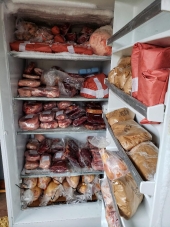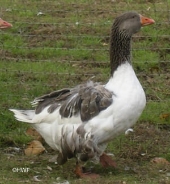




When you reach your lowest point, you are open to the greatest change.
-Avatar Aang








When you reach your lowest point, you are open to the greatest change.
-Avatar Aang




 2
2




Love is the only resource that grows the more you use it.
David Brower
 2
2












 I wasn't sure if canning confit was something you could do at home. A simple cassoulet would be best for me too, I think, though it'd make my great grandmother turn in her grave if she found out haha
I wasn't sure if canning confit was something you could do at home. A simple cassoulet would be best for me too, I think, though it'd make my great grandmother turn in her grave if she found out haha
When you reach your lowest point, you are open to the greatest change.
-Avatar Aang
 2
2




 4
4




 1
1




When you reach your lowest point, you are open to the greatest change.
-Avatar Aang
 1
1




Olga Booker wrote:Hi James,
With a large surplus of birds, my personal choice would be to can it. In fact, here in confit land, most of it is canned these days, simply because it lasts longer and it is safer. With many birds, you'd need a very large fridge or a rodent free cool cellar to keep your open crocks. It is true that depending on conditions, it will keep for a few months without spoiling, but eventually, if you have large quantities and can't eat it fast enough, the fat gets rancid and even mouldy. Wes is right that the birds would be slaughtered when plump and fat.
What I do with my birds is this.
Remove all the fat from the birds, melt the fat with a small amount of water on gentle heat, when fat is melted, add legs, wings and neck if you like it, a few peppercorns, bay leaves and salt and gently simmer, 30-60 minutes until meat is tender and no water runs out when poked with a knife. Immediately put into jars and cover with the fat leaving a 2cm gap, close lid and pressure can for 2 hours, I use 15 pounds pressure but I am at 2 500 feet altitude so you'd have to check for yourself what you need. I have sometimes used a bit of pork fat to top up the jar when the birds were a bit on the lean side. Some people also put nutmeg, rosemary, thyme or other herbs but I prefer things simple - your choice..
I live in Cassoulet country and while making it the traditional way is a long winded process, every housewife used to have her own recipe. I make a very simple version that would make my grandmother turn in her grave if she knew! Basically, I fry the wings, legs and neck in a bit of duck fat and some onions, bay leaves, salt and pepper. When browned, I add some home made tomato sauce or some fresh cut tomatoes (tin is OK), a clove or two of garlic depending on taste and size of pot, and simmer for 10 minutes or so. I then add some previously cooked large white kidney beans and simmer for another half hour. Here we use what is called Tarbais beans, the name comes from the fact that it used to grow around a town called Tarbes. I guess a white navy bean would do. For some reason, white beans seem to lend themselves better to the taste of duck, go figure! Anyway, while still hot, fill up the jars leaving a 2cm gap at the top, close the lid and pressure can for 2 hours (same as above). That way you have a ready meal you can just warm up when you don't feel like cooking and you then can render the fat for other purposes. Roasted potatoes in duck fat are wonderful. A bit of fat added to soups and stews gives a certain richness, and no it is not bad for your health. I also use duck fat to oil some garden tools and waterproof leather boots and canvas or leather hats.
Some of the bird's breasts, after a couple of days at least of "resting", are eaten on the BBQ thinly filleted called "aiguillettes" here, or as kebabs on a stick, or plain fried . Some are added in small chunks in the above mentioned stew, and some I salt for a day and hang up to dry. The dried ones won't last very long and it is best to eat fairly soon, but it is delicious cut thinly in a salad or a few chunks in a soup or stew. It gets drier and harder as time goes by.
The carcass with some meat left on it is boiled in a fair amount of water for several hours (sometimes all night on the edge of the range), again with a few peppercorns, bay leaves and salt, until the meat falls off the bones. While still hot, put into jars (without the bones), lid on and pressure can as above. It makes a clear soup with bits of meat in it that lends itself to all sorts of preparations. I open a jar, warm it up, and add some vermicelli pasta and fresh chopped parsley at the last minute. Or on a winter's day, open a jar or two, add leeks, carrots, celery, potatoes, barley, herbs, whatever you have at hand and make a very hearty stew.
To land on this Kind Pharm has been a blessing and a curse! May your days be yin/yanged and exciting! May those that meet us leave us with a song and smile! Carpe Diem!

|
An electric car saves 2 tons of CO2 out of 30. This tiny ad is carbon neutral.
Learn Permaculture through a little hard work
https://wheaton-labs.com/bootcamp
|







